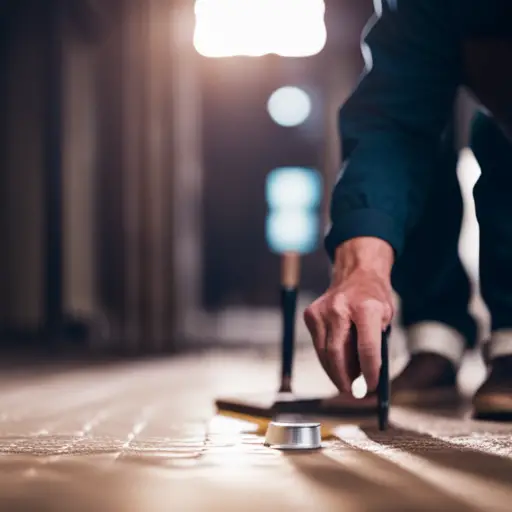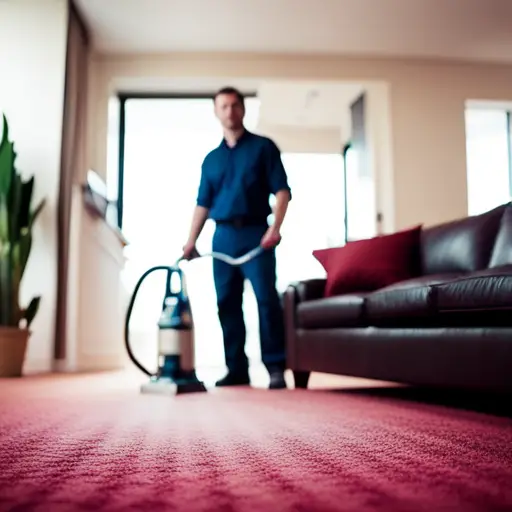The Challenges of Installing Flooring in Older Homes

Did you know that nearly 38% of all homes in the United States were constructed before 1970?
This means that a significant portion of homeowners are faced with the unique challenges of installing flooring in older homes.
From uneven subfloors to historic preservation considerations, navigating the complexities of older home flooring installation requires a deep understanding of both traditional construction methods and modern installation techniques.
Uneven Subfloors
Dealing with uneven subfloors poses a significant challenge when installing flooring in older homes. Before laying new flooring, it is crucial to address any irregularities in the subfloor to ensure a smooth and durable foundation. Leveling techniques are essential in this process, as they help to create a flat surface for the new flooring. This can involve using self-leveling compounds or sanding down high spots and filling in low areas to achieve an even base. Subfloor repair is also vital, as any damaged or weakened areas must be reinforced or replaced to provide adequate support for the new flooring.
Moreover, moisture barriers play a crucial role in preventing moisture from seeping into the new flooring and causing damage. Installing a moisture barrier, such as a plastic sheet or specialized underlayment, can help protect the flooring from potential water damage, particularly in older homes where subfloor moisture may be a concern.
Additionally, selecting the right underlayment is important to provide cushioning, sound absorption, and thermal insulation for the new flooring, enhancing its overall performance and longevity. By addressing these aspects, the challenges of uneven subfloors in older homes can be effectively managed, ensuring a successful flooring installation.
Subfloor Moisture Issues
Addressing subfloor moisture issues is crucial when installing flooring in older homes, as it can prevent potential damage and ensure the longevity of the new flooring. Moisture in subfloors can lead to a variety of problems, including mold growth, warping of wood flooring, and deterioration of adhesives.
To effectively address subfloor moisture issues, consider the following strategies:
-
Mold Prevention and Ventilation: Proper ventilation is essential to prevent moisture buildup in subfloors. Installing vents and ensuring adequate airflow can help mitigate moisture-related problems and inhibit mold growth.
-
Waterproofing and Sealants: Applying waterproofing materials and sealants to the subfloor can create a barrier against moisture intrusion. This is particularly important in areas prone to high humidity or potential water exposure, such as basements or bathrooms.
-
Moisture Testing: Before installing new flooring, conduct moisture tests on the subfloor to identify any existing issues. Addressing these issues beforehand can prevent problems in the future.
-
Professional Assessment: In cases of persistent moisture issues, seeking the expertise of a professional contractor or inspector can provide valuable insights and solutions for effectively managing subfloor moisture.
Non-Standard Room Shapes
Navigating the installation of flooring in older homes becomes particularly challenging when dealing with non-standard room shapes, as they present unique considerations for material layout and fitting. Custom cutting becomes essential when encountering irregular angles, alcoves, or other non-standard features. This requires precise measurements and skilled craftsmanship to ensure a seamless and professional finish. Additionally, creative solutions are often necessary to accommodate these irregularities, such as using transition pieces to bridge gaps between different flooring materials in adjacent rooms or employing specialized techniques to address unconventional layouts.
Furthermore, non-standard room shapes may require a more strategic approach to pattern and seam placement, as standard installation methods may not adequately address the intricacies of the space. In some cases, it may be necessary to adapt the layout of the flooring material to suit the room’s unique shape, which can involve additional time and labor. Despite these challenges, with careful planning and attention to detail, it is possible to achieve a visually appealing and structurally sound result in older homes with non-standard room shapes.
Transitioning into the subsequent section about ‘historic preservation considerations’, addressing the unique architectural features and historical significance of older homes is crucial when planning flooring installations.
Historic Preservation Considerations
The installation of flooring in older homes, especially when faced with non-standard room shapes, requires careful consideration of historic preservation concerns. When dealing with historic homes, it is crucial to prioritize restoration techniques and historical accuracy to maintain the integrity and value of the property.
Here are some key considerations for installing flooring in older homes with a focus on historic preservation:
-
Material Authenticity: Selecting flooring materials that align with the era in which the home was built is essential for historical accuracy. Utilizing reclaimed wood or period-appropriate tile can contribute to maintaining the authentic feel of the space.
-
Preservation of Original Features: Prioritizing the preservation of original flooring, when feasible, is fundamental to maintaining the historical integrity of the home. Restoration techniques such as refinishing, repairing, or reusing existing flooring should be explored before opting for new installations.
-
Architectural Compatibility: Ensuring that the chosen flooring aligns with the architectural style of the home is crucial. This involves considering patterns, colors, and textures that complement the overall design aesthetic of the property.
-
Documentation and Compliance: Adhering to local historic preservation guidelines and obtaining any necessary permits is vital to ensure that the flooring installation meets the requirements for preserving the historical significance of the home.
Structural Integrity Concerns
When confronting the challenges of installing flooring in older homes, it becomes imperative to assess the structural integrity of the existing framework to ensure the longevity and stability of the new flooring.
Foundation stability is a critical consideration, as older homes may have experienced settling or deterioration of the foundation over time. This can lead to uneven flooring and potential damage to the new floor installation. Assessing the foundation stability involves examining the condition of the concrete or support piers, as well as addressing any signs of moisture or water damage that could compromise the integrity of the foundation.
Another vital aspect to consider is the load-bearing capacity of the existing structure. Older homes may have been built to different structural standards, and their load-bearing capacity may be insufficient for modern flooring materials or heavier floor coverings. Evaluating the load-bearing capacity involves understanding the original construction methods and materials used, as well as determining if any structural modifications or reinforcements are necessary to support the new flooring.
Matching New and Existing Flooring
To ensure a cohesive and harmonious transition when installing new flooring in older homes, it is essential to carefully consider how the new flooring will match with the existing flooring, taking into account the materials, colors, and patterns. This is a critical aspect of the installation process that can greatly impact the overall aesthetic and value of the property.
When matching new and existing flooring in older homes, several key factors should be taken into consideration:
-
Color Matching: One of the most important considerations is ensuring that the color of the new flooring complements or matches the existing flooring. This can involve selecting a color that blends seamlessly or creates a deliberate contrast for a visually appealing transition.
-
Transition Options: Exploring various transition options such as T-molding, reducers, or thresholds can help create a smooth and visually pleasing shift between different types of flooring. These transitions can also help to address any height differences between the new and existing flooring.
-
Material Compatibility: Understanding the compatibility of different flooring materials is crucial to ensure the longevity and durability of the installation. It’s important to assess whether the new and existing flooring materials can be seamlessly integrated or if additional measures are required to achieve a cohesive look.
-
Pattern Considerations: If the existing flooring features intricate patterns or designs, it’s important to consider how the new flooring will interact with these existing elements. Whether the goal is to create a seamless flow or a deliberate contrast, the patterns of the new and existing flooring should be thoughtfully evaluated to achieve the desired aesthetic.
Frequently Asked Questions
Can I Install Laminate Flooring Over an Uneven Subfloor in an Older Home?
Yes, laminate flooring can be installed over an uneven subfloor in older homes, but it’s crucial to address any moisture issues, room shapes, and historic preservation concerns. Careful assessment of the existing subfloor and ensuring proper structural support is essential.
How Can I Address Subfloor Moisture Issues Before Installing New Flooring in an Older Home?
Before installing new flooring in an older home, it’s crucial to address subfloor moisture issues. Proper subfloor preparation involves installing moisture barriers, ensuring flooring material compatibility, and assessing ventilation requirements to mitigate moisture-related problems.
What Are Some Tips for Dealing With Non-Standard Room Shapes When Installing Flooring in an Older Home?
Navigating non-standard room shapes when installing flooring in older homes requires strategic planning. Prioritize subfloor leveling to ensure a smooth foundation. Consider the historic significance of the home and address any moisture issues before laying the new flooring.
Are There Specific Considerations for Historic Preservation When Installing New Flooring in an Older Home?
When considering historic preservation in the context of installing new flooring in older homes, it’s crucial to prioritize material choices that align with the home’s historical aesthetic and structural integrity. Maintaining authenticity while ensuring longevity is paramount.
How Can I Determine if the Existing Subfloor and Structure Are Sound Enough to Support New Flooring in an Older Home?
When considering new flooring for an older home, it’s crucial to begin with a thorough subfloor inspection to assess stability. Structural reinforcement may be necessary, requiring a comprehensive assessment to ensure the existing structure can support the new flooring.
Conclusion
In conclusion, installing flooring in older homes presents a variety of challenges, including:
- Uneven subfloors
- Moisture issues
- Non-standard room shapes
- Historic preservation considerations
- Structural integrity concerns
- Matching new and existing flooring
It is important for homeowners and contractors to carefully consider these factors and develop solutions that address the unique characteristics of older homes.
By understanding and addressing these challenges, the installation process can be completed successfully while maintaining the integrity and beauty of the home.

Rubin Everest, a seasoned expert in the world of flooring, brings a wealth of knowledge and passion to the surface. As the mind behind ebbow.com, Rubin is dedicated to sharing insights on the latest trends, innovative solutions, and expert advice in the realm of flooring. Whether you’re seeking practical tips for installation or design inspiration, Rubin Everest is your go-to source for all things flooring-related, making your journey to the perfect floor an informed and enjoyable experience.





